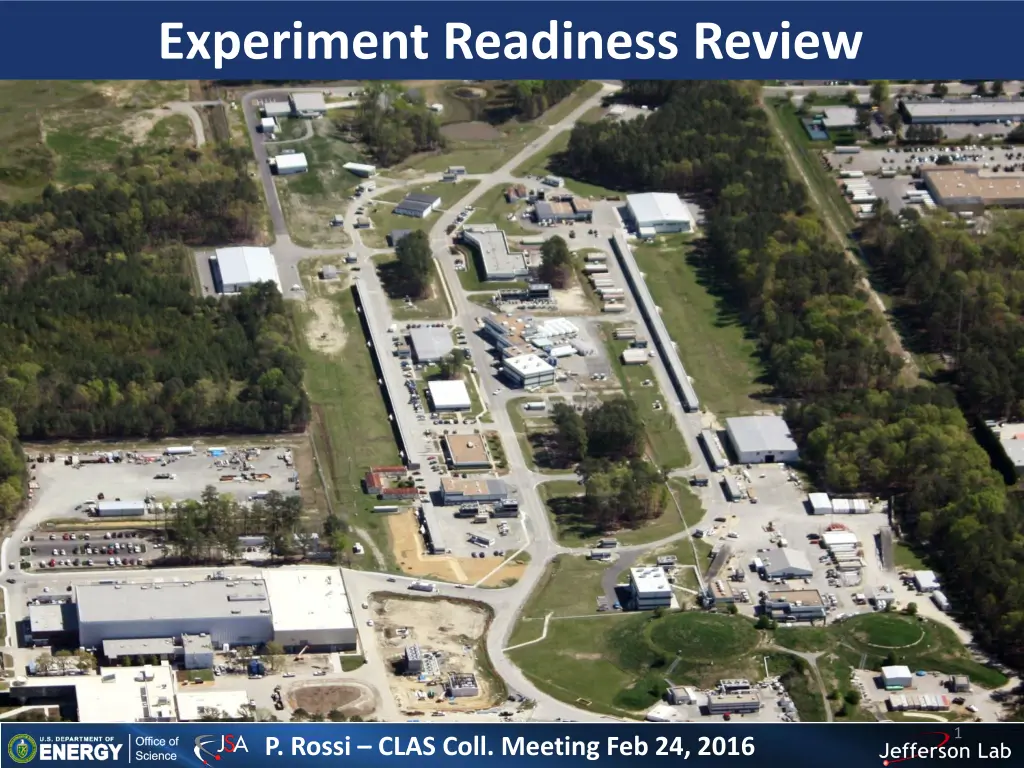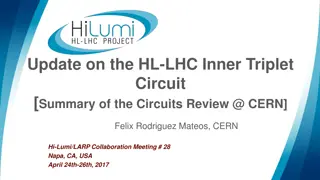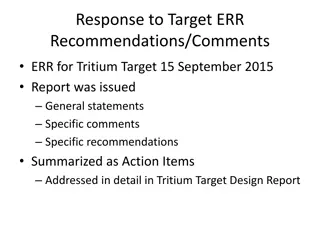
Experiment Readiness Reviews Overview
Learn about the Experiment Readiness Reviews (ERR) process, ensuring safe and efficient operation of experimental equipment by short-stay users. Explore the objectives, phases, and importance of readiness reviews in experimental physics.
Download Presentation

Please find below an Image/Link to download the presentation.
The content on the website is provided AS IS for your information and personal use only. It may not be sold, licensed, or shared on other websites without obtaining consent from the author. If you encounter any issues during the download, it is possible that the publisher has removed the file from their server.
You are allowed to download the files provided on this website for personal or commercial use, subject to the condition that they are used lawfully. All files are the property of their respective owners.
The content on the website is provided AS IS for your information and personal use only. It may not be sold, licensed, or shared on other websites without obtaining consent from the author.
E N D
Presentation Transcript
Experiment Readiness Review 1 P. Rossi CLAS Coll. Meeting Feb 24, 2016
Experiment Readiness Review Process Objective of the Experiment Readiness Review (ERR) is a safe and efficient operation of equipment (and/or an entire experiment) by many short-stay users - i.e., Normal operation will not result in injury to personnel, cause damage to existing equipment, or damage new equipment Have an Experiment Safe & Efficient Plan !! Equipment is ready and will perform as expected - no wasted beam time and no unknown interference with other experiments Don t get caught unprepared Automatic protection measures of personnel & equipment during abnormal situations Operating instructions & boundaries are defined as well as responsible staff 2
Experiment Readiness Reviews @ 12 GeV - 2012-11-06 Hall D Solenoid Cool-down Commissioning Review - 2013-01-09 Hall D Solenoid Power-up Commissioning Review - 2013-07-18 Hall D Solenoid 1st Quench Analysis Review - 2013-12-03 Hall D Tagger Magnet Mapping Review - 2013-12-09 HRSs (Hall A) - 2014-09-18 DVCS/GMp Experiment Readiness Review (Hall A) - 2014-05-08 Hall D Hydrogen Target Safety Review - 2014-07-01 GlueX Experiment Readiness Review (Hall D) - 2014-07-10 HPS Experiment Readiness Review (Hall B) - 2014-08-08 Hall D Photon Beam Commissioning Review - 2015-01-21 Hall C SHMS Q1 Magnet Readiness Review - 2015-03-24 Hall C SHMS HB Magnet Readiness Review - 2015-07-14 Hall D Solenoid 2nd Quench Review - 2015-08-18 Bubble Chamber Readiness Review - 2015-09-15 Tritium Target Readiness Review - 2015-11-12 Prad Readiness Review - 2015-12-07 Darklight Readiness Review 3
Readiness Review Process Flow Chart Submitting Proposals TAC & PAC Process Director s Decision PROPOSAL PHASE Exp. Description and Requirements Exp. Readiness Review Calendar PRELIM. PLANNING PHASE PESAD, specific equipment reviews Complete Conceptual Designs & 1st Readiness Review DESIGN PHASE Fabrication of the equipment Test of the individual elements of the equipment (OSP/TOSP) CONSTRUCTION PHASE Construction near-completed, designs frozen 2nd Readiness Review before scheduling request submission SCHEDULING OF EXPERIMENT by JLab EQUIPMENT INSTALLATION Final readiness review DECOMMISSIONING RUN THE EXPERIMENT http://www.jlab.org/user_resources/PFX/NP-PFX/ 4
ERR in a Nutshell If your experiment includes one-of-a-kind equipment with potential novel safety implications (examples are SC magnets, tritium or high-power cryogenic targets) it requires a first-phase ERR for this equipment at the design stage. If your experiment requires items in the category above and/or equipment beyond the declared base equipment (examples are new detector technologies, new beam lines, new spectrometers), it requires a second-phase ERR before scheduling can be requested. Always check if you need a second-phase ERR well in advance of considering a request for scheduling. If your experiment only includes base equipment (as declared by the Deputy AD) and only in operation modes already executed, or only additional equipment that is a direct clone of base equipment, it only needs a third-phase ERR. 5
ERR in a Nutshell (contd) 1) Before scheduling can be requested the experiment should pass an Experiment Readiness Review by Jefferson Lab's review committee, including subject matter experts. This review will includes: a. Status of the experiment b. Experiment installation plan c. Resource requirements d. Radiation budget e. Timeline 2) After this review, the experiment layout and components are considered frozen, and any design modifications will require a change control, approved by the Division Management (typically the Deputy AD). 3) A final ERR which reviews the readiness of the documentation (ESAD, RSAD, COO, ERG, Safety Check lists, Operational Manual,..) and includes a walkthrough will be scheduled at least one month before the start of the experiment. 4) We are working with the hall leaders what equipment should have an ERR this year, and also for Halls B and C how to fold this in in the general ARR. 6
Nominal Dates for Scheduling Requests Please see the information for the requirements before scheduling can be requested at http://www.jlab.org/user_resources/PFX/NP-PFX/text.html. . You can only request scheduling when construction of all major components of the experiment are completed, as at this stage the experiment layout and components are considered frozen, and any design modifications will require a change control, approved by the Division Management. RE: we plan to shift the dates by one month cuga mail forthcoming June 1 Call for Scheduling (Beam Time) Request June 30 Deadline for Scheduling Request Submissions September 1 Draft 18-Month Schedule Released September 15 Deadline for Input of User Community on Draft Schedule October 1 18-Month Schedule Released Year 1 January - June Schedule Reaffirmed Year 1 July - December Firm Schedule Year 2 January - June Tentative Schedule March 1 Draft 18-Month Schedule Released March 15 April 1 Deadline for Input of User Community on Draft Schedule 18-Month Schedule Released Year 1 July December Schedule Reaffirmed Year 2 January - June Firm Schedule Year 2 July - December Tentative Schedule 7
RE: we work on 2016/17 schedule revisions now Beam Schedule: 2016 Date Acc Hall A Hall B Hall C Hall D 1/28 Beam Rest. 2/4 DVCS/GMp HPS/w-end GlueX Comm. 3/14-16 Facility Dev. TBD Prad Install. Beam Line Check TBD 3/17-4/7 Beam Rest. DVCS/GMp Prad Install. - GlueX Comm. 4/8-10 Beam DVCS/GMp Prad Comm. GlueX Comm. 4/11-13 Beam DVCS/GMp - - GlueX Comm. 5/1-28 Beam - PRad - - 5/30-6/19 Inj. Fac. Dev. 8/15-28 Inj. Fac. Dev. 8/29-9/5 Facility Dev. - - Checkout 10/8-12 Beam Target Inst. - Beamline Com. (Includes Moller+Compton) GlueX 10/13-23 E12-10-103 - BeamLine Comm + Detector Com. Gluex 10/25-11/16 Beam E12-10-103 - E12-06-107 Gluex 11/17-12/18 Beam E12-10-103 - E12-10-002/008 Gluex 8 12/19-21 4 Halls Demo TBD Beam ? TBD TBD
RE: we work on 2016/17 schedule revisions now Beam Schedule: 2017 Date Acc Hall A Hall B Hall C Hall D 2/10-16 Beam Rest. 2/17 - Beamline Com. E12-10-002 - 2/18-24 E12-11-112 Beamline com E12-10-003 GlueX 2/25-3/9 E12-11-112 CLAS12 com. E12-09-017 GlueX 3/10-28 E12-11-112 Eng. run E12-09-017 GlueX 3/29-4/3 E12-10-103 Eng. run E12-09-017 GlueX 4/5-7 E12-11-112 Eng. run E12-09-017 GlueX 4/9-10 E12-10-103 Eng. run E12-09-017 GlueX 4/11-5/1 E12-14-011 Eng. run E12-09-002 GlueX 5/2-9 E12-14-011 Eng. run E12-09-011 GlueX 5/10-30 TBD Eng. run E12-09-011 GlueX 6/2-4 E12-14-009 Eng. run E12-09-011 GlueX 9
Experiment Readiness Reviews: Hall B Calendar March 25, 2016: PRad 3rd ERR Focus of the review: DAQ, documentation, walkthrough April 13, 2016: Torus Cooldown RE: this may not be exactly as projected by Glenn/12 GeV anymore May 2016 (last week?) : Torus Power up 13-14 June 2016: Ancillary equipment [CND, FT, Micromega (MVT+FMT), RICH] October 2016: Solenoid Cooldown Committee: the same as of the Torus November/December 2016: Solenoid Power up Committee: the same as of the Torus 1st week January 2017: CLAS12 ERR 1st phase (includes documentations) ?: last CLAS12 ERR 2nd phase 10
HALL B / CLAS12 TENTATIVE EQUIPMENT PLAN FOR 2017/2018 Run Period Program 12GeV Base CND MVT (layers) FMT FT RICH 2/24/17- 3/09/17 KPP 1 3/10 6/04 Engineering run 1 Fall 2017 RG A 3 Spring 2018 RG A & RG B 3 MVT: Barrel Micromega. MVT 1: 1 MM layer + 4 SVT layers. MVT 3: 3 MM layer + 3 SVT layers. FMT: Forward Micromega 11
CLAS12 Ancillary Equipment ERR: Charge 1. Have ESH&Q considerations been properly included in the design of the detector? 2. Is the detector completed and ready to operate? If not, what is the completion/commissioning schedule and tasks? 3. Has the process of integration into CLAS12 been: a. Defined? I.e. have all the jobs that need to be done to safely mount the detector identified? b. Responsible parties for carrying out each job identified and available? c. Process reviewed and scheduled? 4. Are the specific documentation and procedures to operate safely and efficiently the detector, in place and adequate? This includes initial operation. 5. Has the detector ownership, maintenance and control been defined during beam operations? 12
Charge 1 Have the EHS&Q considerations been properly included in the design of the detector? Jefferson Lab has identified a list of hazard issues relevant to current operations. The information is stored in the EHS&Q manual 2410 Appendix T1 Hazard Issues List (https://www.jlab.org/ehs/ehsmanual/2410T1.htm) Safety consideration of new equipment (or potential new hazards to existing equipment) are usually reviewed at the stages II. (Approved Proposal: Preliminary Planning Phase) and III. (Design Phase) of the Readiness Review Process (https://www.jlab.org/user_resources/PFX/NP-PFX/). At that stage a technical review of design calculations or specifications is carry out to verify accuracy and compliance to predetermined requirements; national consensus codes; industry standards; or common scientific, engineering practice. This review is completed by a Design Authority other than the Design Authority responsible for the design. In the case of CLAS12 ancillary equipment only few of them have undergone this design phase review. The spokespersons of the experiment using the ancillary detector have to demonstrate that none of the JLab safety regulations have been broken during the detector construction, and for the detector operation, that safety issues (if any) have been identified and that mitigating measures have been incorporated. 13
Charge 4 Are the specific documentation and procedures to operate safely and efficiently the detector, in place and adequate? This includes initial operation. Documentation Description of the detector Hazards Mitigations Responsible personnel Examples: Mitigation Hazard Hazard Power off before disconnecting cables Red flashing beacons, Lock and Tag for any work on the magnets, .. Electrical shock from HV, LV Magnetic field This document will be part of the CLAS12 Commissioning ESAD The HPS ESAD is a good example how to write the documentation: https://www.jlab.org/Hall-B/run-web/hps/ESAD_HallB-HPS.pdf (Note: copy and paste the link to get link access) 14
Charge 4 (contd) Operation Manual This can be a collection of OSP/TOSP (Operation Safety Procedure/Temporary Operation Safety Procedure) A good example of an Operational Manuale is the HPS SVT one: https://wiki.jlab.org/hps-run/images/3/3e/OPS_Manual_SVT.pdf (Note: copy and paste the link to get link access) Commissioning Manual The purpose of this document is to describe the procedures that will be followed to commission the detector. The goal of these procedures is to : - ensure the proper functioning of the detector - ensure the quality standards of the detector - obtain initial calibration data for the reconstruction of physics events - determine the performance of the detector, and - optimize the overall detector configuration according to the requirements of the physics runs. You can find several examples in the HPS wiki page: https://wiki.jlab.org/hps-run/index.php/The_HPS_Run_Wiki 15
Charge 2,3,5 2. Is the detector completed and ready to operate? If not, what is the completion/commissioning schedule and tasks? 3. Has the process of integration into CLAS12 been: a. Defined? I.e. have all the jobs that need to be done to safely mount the detector identified? b. Responsible parties for carrying out each job identified and available? c. Process reviewed and scheduled? 5. Has the detector ownership, maintenance and control been defined during beam operations? These are self-explaining charges but if you want to have a good example of a recent Experiment Readiness Review (charge, presentations, documentation) see the HPS ERR web page: https://confluence.slac.stanford.edu/display/hpsg/HPS+Readiness+Review+July+10%2C+2014 (Note: copy and paste the link to get link access) 16
Summary The existing model to run an experiment at Jefferson Lab seems to be working well, with very good communication, coordination, and cooperation amongst multiple divisions, and roles and responsibilities well defined. Before scheduling can be requested the experiment should pass an Experiment Readiness Review by Jefferson Lab's review committee, including subject matter experts. After this review, the experiment layout and components are considered frozen, and any design modifications will require a change control, approved by the Division Management (typically the Deputy AD). The ERR for the Hall B Ancillary Equipment has been schedule for June 13- 14, 2016. Other important dates are: - TORUS ERR: April-May 2016 - Solenoid ERR: October-December 2016 - CLAS12 ERR (1st phase) : first week of January 2017. 17










